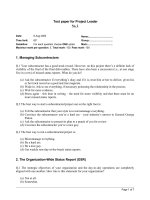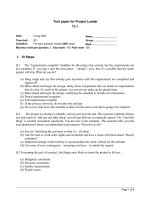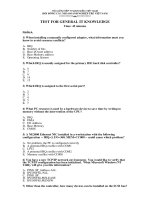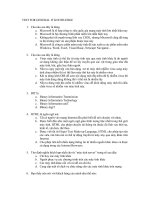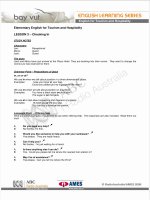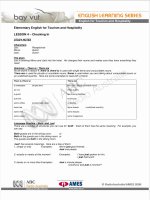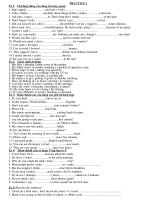Electricity for boys
Bạn đang xem bản rút gọn của tài liệu. Xem và tải ngay bản đầy đủ của tài liệu tại đây (982.61 KB, 174 trang )
TheProjectGutenbergEBookofElectricityforBoys,byJ.S.Zerbe
ThiseBookisfortheuseofanyoneanywhereatnocostandwith
almostnorestrictionswhatsoever.Youmaycopyit,giveitawayor
re-useitunderthetermsoftheProjectGutenbergLicenseincluded
withthiseBookoronlineatwww.gutenberg.org
Title:ElectricityforBoys
Author:J.S.Zerbe
ReleaseDate:September25,2007[EBook#22766]
Language:English
***STARTOFTHISPROJECTGUTENBERGEBOOKELECTRICITYFORBOYS***
ProducedbyJoeLongoandtheOnlineDistributed
ProofreadingTeamat
WARNING:Thisbookofonehundredyearsago
describes
experimentswhicharetoodangeroustoattemptby
either
adultsorchildren.Itispublishedforhistorical
interestonly.
THE"HOW-TO-DO-IT"BOOKS
ELECTRICITYFORBOYS
Fig.1.WORKBENCH
Fig.1.WORKBENCH
THE "HOW-TO-DO-IT"
BOOKS
ELECTRICITYFOR
BOYS
A working guide, in the successive
steps of electricity, described in
simpleterms
WITH MANY ORIGINAL
ILLUSTRATIONS
ByJ.S.ZERBE,M.E.
AUTHOROF
CARPENTRYFORBOYS
PRACTICALMECHANICSFOR
BOYS
Printer'sMark:NYBC/Windmill
THENEWYORKBOOKCOMPANY
NEW YORK
COPYRIGHT,1914,BY
THENEWYORKBOOKCOMPANY
p.i
CONTENTS
INTRODUCTORY
Page1
I.
ELECTRICITYCONSIDERED.BRIEFHISTORICAL
EVENTS
Page5
The Study of Electricity. First Historical
Accounts. Bottling Electricity. Discovery of
Galvanic Electricity. Electro-motive Force.
Measuring Instruments. Rapidity of Modern
Progress. How to Acquire the Vast Knowledge.
TheMeansEmployed.
II. WHATTOOLSANDAPPARATUSARENEEDED
Page11
PreparingtheWorkshop.UsesofOurWorkshop.
What to Build. What to Learn. Uses of the
ElectricalDevices.Tools.Magnet-windingReel.
III. MAGNETS,COILS,ARMATURES,ETC.
Page18
TheTwoKindsofMagnets.PermanentMagnets.
Electro-Magnets. Magnetism. Materials for
Magnets. Non-magnetic Material. Action of a
Second Magnet. What North and South Pole
Mean. Repulsion and Attraction. Positives and
Negatives.MagneticLinesofForce.TheEarthas
a Magnet. Why the Compass Points North and
South. Peculiarity of a Magnet. Action of the
Electro-Magnet. Exterior Magnetic Influence
Around a Wires Carrying a Current. Parallel
Wires.
IV.
FRICTIONAL,VOLTAICORGALVANICAND
ELECTRO-MAGNETICELECTRICITY
Page29
p.ii
Three Electrical Sources. Frictional Electricity.
L e y d e nJar. Voltaic or Galvanic Electricity.
Voltaic Pile; How Made. Plus and Minus Signs.
The Common Primary Cell. Battery Resistance.
Electrolyte and Current. Electro-magnetic
Electricity. Magnetic Radiation. Different Kinds
of Dynamos. Direct Current Dynamos. Simple
MagnetConstruction.HowtoWind.TheDynamo
Fields. The Armature. Armature Windings.
Mounting the Armature. The Commutator.
Commutator Brushes. Dynamo Windings. The
Field. Series-wound Field. Shunt-wound.
Compound-wound.
V. HOWTODETECTANDMEASUREELECTRICITY
Page49
Measuring Instruments. The Detector. Direction
of Current. Simple Current Detector. How to
Place the Detector. Different Ways to Measure a
Current. The Sulphuric Acid Voltameter. The
Copper Voltameter. The Galvanoscope Electromagnetic Method. The Calorimeter. The Light
Method. The Preferred Method. How to Make a
Sulphuric Acid Voltameter. How to Make a
Copper Voltameter. Objections to the
Calorimeter.
VI. VOLTS,AMPERES,OHMSANDWATTS
Page60
Understanding Terms. Intensity and Quantity.
Voltage. Amperage Meaning of Watts and
Kilowatt. A Standard of Measurement. The
Ampere Standard. The Voltage Standard. The
Ohm.CalculatingtheVoltage.
PUSHBUTTONS,SWITCHES,ANNUNCIATORS,
VII. BELLSANDLIKEAPPARATUS
Page65
Simple Switches. A Two-Pole Switch. DoublePole Switch. Sliding Switch. Reversing Switch.
Push Buttons.Electric Bells. How Made. How
Operated. Annunciators. Burglar Alarm. Wire
Circuiting.CircuitingSystemwithTwoBellsand
Push Buttons. The Push Buttons, Annunciators
andBells.WiringUpaHouse.
VIII.
ACCUMULATORS,STORAGEORSECONDARY
BATTERIES
Page82
Storing Up Electricity. The Accumulator.
Accumulator Plates. The Grid. The Negative
Pole. Connecting Up the Plates. Charging the
Cells.TheInitialCharge.TheChargingCurrent.
IX. THETELEGRAPH
Page90
Mechanism in Telegraph Circuit. The Sending
Key. The Sounder. Connecting Up the Key and
Sounder. Two Stations in Circuit. The Double
Click. Illustrating the Dot and the Dash. The
MorseTelegraphCode.ExampleinUse.
X. HIGH-TENSIONAPPARATUS,CONDENSERS,ETC.
Page98
Induction. Low and High Tension. Elastic
Property of Electricity. The Condenser.
ConnectingupaCondenser.TheInterrupter.Uses
ofHigh-tensionCoils.
XI. WIRELESSTELEGRAPHY
Page104
Telegraphing Without Wires. Surging Character
of High-tension Currents. The Coherer. How
Made. The Decoherer. The Sending Apparatus.
The Receiving Apparatus. How the Circuits are
Formed.
XII. THETELEPHONE
Page110
Vibrations. The Acoustic Telephone. Sound
Waves.Hearing Electricity. The Diaphragm in a
Magnetic Field. A Simple Telephone Circuit.
How to Make a Telephone. Telephone
Connections. Complete Installation. The
Microphone.LightContactPoints.HowtoMake
a Microphone. Microphone, the Father of the
Transmitter. Automatic Cut-outs for Telephones.
CompleteCircuitingwithTransmitters.
XIII.
ELECTROLYSIS,WATERPURIFICATION,
ELECTROPLATING
Page123
Decomposing Liquids. Making Hydrogen and
Oxygen. Purifying Water. Rust. Oxygen as a
Purifier.CompositionofWater.CommonAirNot
a Good Purifier. Pure Oxygen a Water Purifier.
The Use of Hydrogen in Purification.Aluminum
Electrodes. Electric Hand Purifier. Purification
and Separation of Metals. Electroplating. Plating
IronwithCopper.DirectionofCurrent.
XIV. ELECTRICHEATING.THERMO-ELECTRICITY
Page135
Generating Heat in a Wire. Resistance of
Substances. Signs of Connectors. Comparison of
Metals. A Simple Electric Heater. How to
Arrange for Quantity of Current Used. An
Electric Iron. Thermo-Electricity Converting
Heat Directly into Electricity Metals. Electric,
Positive,Negative.Thermo-electricCoupler.
XV.
ALTERNATINGCURRENTS,CHOKINGCOIL,
TRANSFORMER
Page145
Direct Current. Alternating Current. The
Magnetic Field. Action of a Magnetized Wire.
The Movement of a Current in a Charged Wire.
Current Reversing Itself. Self-Induction. Brushes
inaDirectCurrentDynamo:Alternating,Positive
and Negative Poles. How anAlternating Current
Dynamo is Made. The Windings. The Armature
Wires.ChokingCoils.TheTransformer.Howthe
Voltage is Determined.Voltage andAmperage in
Transformers.
XVI. ELECTRICLIGHTING
Page161
Earlyconditions.Fuels.ReversibilityofDynamo.
Electric arc. Mechanism to maintain the arc.
Resistance coil. Parallel carbons for making arc.
Series current. Incandescent system. Multiple
circuit. Subdivision of electric light. The
filament. The glass bulb. Metallic filaments.
Vapor lamps. Directions for improvements. Heat
in electric lighting. Curious superstitions
concerning electricity. Magnetism. Amber.
Discovery of the properties of a magnet.
Electricity in mountain regions. Early beliefs as
to magnetism and electricity. The lightning rod.
Protests against using it. Pliny's explanation of
electricity.
XVII.
POWER,ANDVARIOUSOTHERELECTRICAL
MANIFESTATIONS
Page175
Early beliefs concerning the dynamo.
Experiments with magnets. Physical action of
dynamo and motor. Electrical influence in
windings. Comparing motor and dynamo. How
thecurrentactsinadynamo.Itsforceinamotor.
Loss in power transmission. The four ways in
which power is dissipated. Disadvantages of
electric power. Its advantages. Transmission of
energy. High voltages. The transformer. Stepdowntransformers.Electricfurnaces.Weldingby
electricity. Merging the particles of the joined
ends.
XVIII. X-RAY,RADIUMANDTHELIKE
Page184
The camera and the eye. Actinic rays. Hertzian
waves. High-tension apparatus. Vacuum tubes.
Character of the ultra-violet rays. How
distinguished. The infra-red rays. Their uses. Xrays not capable of reflection. Not subject to
refraction. Transmission through opaque
substances.Reducingratesofvibration.Radium.
Radio-activity.
Radio-active
materials.
Pitchblende. A new form of energy. Electrical
source.Healingpower.Problemsforscientists.
GLOSSARYOFWORDSUSEDINTHETEXT
INDEX
Page189
Page207
p.vii
LISTOFILLUSTRATIONS
1. Workbench
2. Topofmagnet-windingreel
3. Sideofmagnet-windingreel
4. Journalblock
5. Plainmagnetbar
6. Severedmagnet
7. Reversedmagnets
8. Horseshoemagnet
9. Earth'smagneticlines
10. Twopermanentmagnets
11. Magnetsinearth'smagneticfield
12. Armaturesformagnets
13. Magnetizedfield
14. Magnetizedbar
15. Directionofcurrent
16. Directionofinductioncurrent
17. Frictional-electricitymachine
18. Leydenjar
19. Galvanicelectricity.Crownofcups
20. Voltaicelectricity
21. Primarybattery
22. Dynamofieldandpolepiece
23. Baseandfieldsassembled
24. Detailsofthearmature,core
25. Detailsofthearmature,body
26. ArmatureJournals
27. Commutator
28. Endviewofarmature,mounted
Frontispiece
PAGE
14
14
15
19
20
21
22
23
24
24
25
26
26
27
28
30
32
33
34
36
39
41
42
42
43
43
44
p.viii
29. Topviewofarmatureonbase
30. Fieldwinding
31. Series-wound
32. Shunt-wound
33. Compound-wound
34. Compassmagnet,swingtotheright
35. Magneticcompass
36. Magnet,swingtotheleft
37. Indicatingdirectionofcurrent
38. Thebridgeofthedetector
39. Detailsofdetector
40. Cross-sectionofdetector
41. Acidvoltameter
42. Coppervoltameter
43. Two-poleswitch
44. Double-poleswitch
45. Slidingswitch
46. Rheostatformofswitch
47. Reversingswitch
48. Pushbutton
49. Electricbell
50. Armatureofelectricbell
51. Verticalsectionofannunciator
52. Frontviewofannunciator
53. Horizontalsectionofannunciator
54. Frontplateofannunciator
55. Alarmswitchonwindow
56. Burglaralarmonwindow
57. Burglaralarmcontact
58. Neutralpositionofcontact
59. Circuitingforelectricbell
60. Annunciatorsincircuit
61. Wiringsystemforahouse
45
47
47
48
48
50
50
50
51
52
53
54
56
56
66
66
67
68
69
70
71
72
72
72
72
72
76
76
77
78
79
80
80
62. Accumulatorgrids
83
63. Assemblageofaccumulatorgrids
64. Connectingupstoragebatteryinseries
65. Parallelseries
66. Chargingcircuit
67. Telegraphsendingkey
68. Telegraphsounder
69. Atelegraphcircuit
70. Inductioncoilandcircuit
71. Illustratingelasticity
72. Condenser
73. High-tensioncircuit
74. Currentinterrupter
75. Wireless-telegraphycoherer
76. Wirelesssending-apparatus
77. Wirelessreceiving-apparatus
78. Acoustictelephone
79. Illustratingvibrations
80. Themagneticfield
81. Sectionoftelephonereceiver
82. Themagnetandreceiverhead
83. Simpletelephoneconnection
84. Telephonestationsincircuit
85. Illustratinglightcontactpoints
86. Themicrophone
87. Thetransmitter
88. Completetelephonecircuit
89. Deviceformakinghydrogenandoxygen
90. Electric-waterpurifier
91. Portableelectricpurifier
92. Sectionofpositiveplate
93. Sectionofnegativeplate
94. Positiveandnegativeinposition
85
87
88
88
91
92
94
99
100
101
102
103
105
107
108
111
111
112
114
115
116
117
118
119
119
121
124
127
129
130
130
130
95. Formoftheinsulator
96. Simpleelectricheater
97. Sideviewofresistancedevice
98. Topviewofresistancedevice
99. Planviewofelectriciron
100. Sectionofelectriciron
101. Thermo-electriccouple
102. Cuttingamagneticfield
103. Alternations,firstposition
104. Alternations,secondposition
105. Alternations,thirdposition
106. Alternations,fourthposition
107. Increasingalternations,firstview
108. Increasingalternations,secondview
109. Connectionofalternatingdynamoarmature
110. Directcurrentdynamo
111. Circuitwiresindirectcurrentdynamo
112. Alternatingpolaritylines
113. Alternatingcurrentdynamo
114. Chokingcoil
115. Atransformer
116. Parallelcarbons
117. Arc-lightingcircuit
118. Interruptedconductor
119. Incandescentcircuit
120. Magneticactionindynamo,1st
121. Magneticactionindynamo,2d
122. Magneticactionindynamo,3d
123. Magneticactionindynamo,4th
124. Magneticactioninmotor,1st
125. Magneticactioninmotor,2d
126. Magneticactioninmotor,3d
127. Magneticactioninmotor,4th
130
137
139
139
140
141
143
146
148
148
148
148
149
149
150
151
152
154
155
157
158
164
165
166
167
177
177
178
178
179
179
180
180
p.1
INTRODUCTORY
Electricity,likeeveryscience,presentstwophasestothestudent,onebelonging
to a theoretical knowledge, and the other which pertains to the practical
applicationofthatknowledge.Theboyisdirectlyinterestedinthepracticaluse
whichhecanmakeofthiswonderfulphenomenoninnature.
Itis,inreality,themostsuccessfulavenuebywhichhemayobtainthetheory,
forhelearnstheabstractmorereadilyfromconcreteexamples.
Itisanartinwhichshoppracticeisagreatereducatorthancanbepossiblewith
books.Boysarenot,generally,inclinedtospeculateortheorizeonphenomena
apart fromthe workitself;butonceputthemintocontactwiththemechanism
itself,letthembecomealivingpartofit,andtheywillcommencetoreasonand
thinkforthemselves.
Itwouldbeadry,dullanduninterestingthingtotellaboythatelectricitycanbe
p.2
generatedbyrivetingtogethertwopiecesofdissimilarmetals,andapplyingheat
to the juncture. But put into his hands the metals, and set him to perform the
actualworkofrivetingthemetalstogether,thenwiringuptheendsofthemetals,
heating them, and, with a galvanometer, watching for results, it will at once
make him see something in the experiment which never occurred when the
abstracttheorywaspropounded.
He will inquire first what metals should be used to get the best results, and
finally, he will speculate as to the reasons for the phenomena. When he learns
that all metals are positive-negative or negative-positive to each other, he has
grasped a new idea in the realm of knowledge, which he unconsciously traces
back still further, only to learn that he has entered a field which relates to the
constitution of matter itself. As he follows the subject through its various
channels he will learn that there is a common source of all things; a
manifestationcommontoallmatter,andthatallsubstancesinnaturearelinked
togetherinamostwonderfulway.
Animpulsemustbegiventoaboy'straining.Thetimeispastfortherule-androte method. The rule can be learned better by a manual application than by
committingasentencetomemory.
p.3
In the preparation of this book, therefore, I have made practice and work the
predominatingfactors.Ithasbeenmyaimtosuggestthebestforminwhichto
dothethingsinapracticalway,andfromthatwork,astheboycarriesitout,to
deducecertainlawsanddeveloptheprincipleswhichunderliethem.Whereverit
isdeemedpossibletodoso,itisplannedtohavetheboymakethesediscoveries
forhimself,soastoencouragehimtobecomeathinkerandareasonerinsteadof
ameremachine.
A boy does not develop into a philosopher or a scientist through being told he
mustlearntheprinciplesofthisteaching,orthefundamentalsofthatschoolof
reasoning.Hewillunconsciouslyimbibethespiritandthewillingnessifwebut
place before him the tools by which he may build even the simple machinery
thatdisplaysthevariouselectricalmanifestations.
p.5
CHAPTERI
THESTUDYOFELECTRICITY.HISTORICAL
Thereisnostudysoprofoundaselectricity.Itisamarveltothescientistaswell
as to the novice. It is simple in its manifestations, but most complex in its
organization and in its ramifications. It has been shown that light, heat,
magnetism and electricity are the same, but that they differ merely in their
modesofmotion.
FIRSTHISTORICALACCOUNT.—Thefirsthistoricalaccountofelectricitydatesback
to600yearsB.C.ThalesofMiletuswasthefirsttodescribethepropertiesof
amber, which, when rubbed, attracted and repelled light bodies. The ancients
also described what was probably tourmaline, a mineral which has the same
qualities.Thetorpedo,afishwhichhasthepowerofemittingelectricimpulses,
wasknowninveryearlytimes.
From that period down to about the year 1600 no accounts of any historical
valuehavebeengiven.Dr.Gilbert,ofEngland,madeanumberofresearchesat
thattime,principallywithamberandothermaterials,andBoyle,in1650,made
numerousexperimentswithfrictionalelectricity.
Sir Isaac Newton also took up the subject at about the same period. Inp.61705
Hawksbee made numerous experiments; also Gray, in 1720, and a Welshman,
Dufay, at about the same time. The Germans, from 1740 to 1780, made many
experiments.In1740,atLeyden,wasdiscoveredthejarwhichbearsthatname.
Beforethattime,allexperimentsbeganandendedwithfrictionalelectricity.
The first attempt to "bottle" electricity was attempted by Muschenbrœck, at
Leyden,whoconceivedtheideathatelectricityinmaterialsmightberetainedby
surroundingthemwithbodieswhichdidnotconductthecurrent.Heelectrified
some water in a jar, and communication having been established between the
water and the prime conductor, his assistant, who was holding the bottle, on
tryingtodisengagethecommunicatingwire,receivedasuddenshock.
In1747SirWilliamWatsonfiredgunpowderbyanelectricspark,and,lateron,
apartyfromtheRoyalSociety,inconjunctionwithWatson,conductedaseries
of experiments to determine the velocity of the electric fluid, as it was then
termed.
BenjaminFranklin,in1750,showedthatlightningwaselectricity,andlateron
madehisinterestingexperimentswiththekiteandthekey.
DISCOVERING GALVANIC ELECTRICITY.—The great discovery of Galvani, in 1790,
ledtotherecognitionofanewelementinelectricity,calledgalvanicorvoltaic
(named after the experimenter, Volta), and now known to be identical with
frictional electricity. In 1805 Poisson was the first to analyze electricity; and
when Œrsted of Copenhagen, in 1820, discovered the magnetic action of
electricity, it offered a great stimulus to the science, and paved the way for
investigationinanewdirection.Amperewasthefirsttodeveloptheideathata
motororadynamocouldbemade operative by means ofthe electro-magnetic
current;andFaraday,about1830,discoveredelectro-magneticrotation.
ELECTRO-MAGNETICFORCE.—Fromthistimeontheknowledgeofelectricitygrew
withamazingrapidity.Ohm'sdefinitionofelectro-motiveforce,currentstrength
and resistance eventuated into Ohm's law. Thomson greatly simplified the
galvanometer, and Wheatstone invented the rheostat, a means of measuring
resistance,about1850.ThenprimarybatterieswerebroughtforwardbyDaniels,
Grove, Bunsen and Thomson, and electrolysis by Faraday. Then came the
instruments of precision—the electrometer, the resistance bridge, the ammeter,
thevoltmeter—alloftheutmostvalueinthescience.
MEASURINGINSTRUMENTS.—Theperfectionofmeasuringinstrumentsdidmoreto
advanceelectricitythanalmostanyotherfieldofendeavor;sothatafter1875the
inventors took up the subject, and by their energy developed and put into
practical operation a most wonderful array of mechanism, which has become
valuableintheserviceofmaninalmosteveryfieldofhumanactivity.
RAPIDITYOFMODERNPROGRESS.—Thisbriefhistoryisgivenmerelytoshowwhat
wondershavebeenaccomplishedinafewyears.Theartisreallylessthanfifty
yearsold,andyetsorapidlyhasitgoneforwardthatitisnotatallsurprisingto
heartheremark,thattheendofthewondershasbeenreached.LessthantwentyfiveyearsagoahighofficialoftheUnitedStatesPatentOfficestatedthatitwas
probable the end of electrical research had been reached. The most wonderful
developments have been made since that time; and now, as in the past, one
discoveryisbutthepreludetoanotherstillmoreremarkable.Wearebeginning
tolearnthatweareonlyonthethresholdofthatstorehouseinwhichnaturehas
lockedhersecrets,andthatthereisnolimittohumaningenuity.
HOW TO ACQUIRE THE VAST KNOWLEDGE.—As the boy, with his limited vision,
surveys this vast accumulation of tools, instruments and machinery, and sees
whathasbeenandisnowbeingaccomplished,itisnottobewonderedatthathe
should enter the field with timidity. In his mind the great question is, how to
acquiretheknowledge.Thereissomuchtolearn.Howcanitbeaccomplished?
The answer to this is, that the student of to-day has the advantage of the
knowledgeofallwhohavegonebefore;andnowthepertinentthingistoacquire
thatknowledge.
THEMEANSEMPLOYED.—Thisbringsusdefinitelydowntoanexaminationofthe
means that we shall employ to instil this knowledge, so that it may become a
permanentassettothestudent'sstoreofinformation.
The most significant thing in the history of electrical development is the
knowledge that of all the great scientists not one of them ever added any
knowledge to the science on purely speculative reasoning. All of them were
experimenters. They practically applied and developed their theories in the
laboratoryortheworkshop.Thenaturalinferenceis,therefore,thattheboywho
startsouttoacquireaknowledgeofelectricity,mustnotonlytheorize,butthat
heshall,primarily,conducttheexperiments,andtherebyacquiretheinformation
in a practical way, one example of which will make a more lasting impression
thanpagesofdrytext
Throughout these pages, therefore, I shall, as briefly as possible, point out the
theoriesinvolved,asafoundationforthework,andthenillustratethestructural
typesorsamples;andtheworkissoarrangedthatwhatisdoneto-dayismerely
apreludeorstepping-stonetothenextphaseoftheart.Inreality,weshalltravel,
toaconsiderableextent,thecoursewhichthegreatinvestigatorsfollowedwhen
they were groping for the facts and discovering the great manifestations in
nature.
p.11
CHAPTERIIToC
WHATTOOLSANDAPPARATUSARENEEDED
PREPARING THE WORKSHOP.—Before commencing actual experiments we should
preparetheworkshopandtools.Sincewearegoingintothisworkaspioneers,
we shall have to be dependent upon our own efforts for the production of the
electricalapparatus,soastobeable,withourhome-madefactory,toprovidethe
power, the heat and the electricity. Then, finding we are successful in these
enterprises,wemaylookforwardfor"moreworldstoconquer."
Bythistimeourneighborswillbecomeinterestedinandsolicitworkfromus.
USES OF OUR WORKSHOPS.—They may want us to test batteries, and it then
becomesnecessarytoconstructmechanismtodetectandmeasureelectricity;to
installnewandimprovedapparatus;andtoputinandconnectupelectricbellsin
their houses, as well as burglar alarms. To meet the requirements, we put in a
telegraph line, having learned, as well as we are able, how they are made and
operated. But we find the telegraph too slow and altogether unsuited for our
p.12
purposes,aswellasfortheusesoftheneighborhood,soweconcludetoputina
telephonesystem.
WHAT TOBUILD.—Itisnecessary,therefore,tocommencerightatthebottomto
build a telephone, a transmitter, a receiver and a switch-board for our system.
From the telephone we soon see the desirability of getting into touch with the
greatoutsideworld,andwirelesstelegraphyabsorbsourtimeandenergies.
Butaswelearn moreand moreofthewonderfulthingselectricitywilldo,we
are brought into contact with problems which directly interest the home.
Sanitationattractsourattention.Whycannotelectricityactasanagenttopurify
ourdrinkingwater,tosterilizesewageandtoarrestoffensiveodors?Wemust,
therefore,learnsomethingaboutthesubjectofelectrolysis.
WHATTOLEARN.—Thedecompositionofwaterisnottheonlythingthatweshall
describe pertaining to this subject. We go a step further, and find that we can
decomposemetalsaswellasliquids,andthatwecanmakeapuremetaloutof
animpureone,aswellasmakethefoulestwaterpure.Butweshallalso,inthe
course ofourexperiments, findthatacheapmetalcanbecoatedwithacostly
p.13
onebymeansofelectricity—thatwecanelectroplatebyelectrolysis.
USES OF THEELECTRICALDEVICES.—Whileallthisisprogressingandourfactory
isturningoutanamazingvarietyofusefularticles,weareledtoinquireintothe
usestowhichwemaydevoteoursurpluselectricity.Thecurrentmaybediverted
forboilingwater;forweldingmetals;forheatingsad-irons,aswellasforother
purposeswhicharedailyrequired.
TOOLS.—Todothesethingstoolsarenecessary,andforthepresenttheyshould
notbeexpensive.Asmall,rigidlybuiltbenchisthefirstrequirement.Thismay
bemade,asshowninFig.1,ofthree2-inchplanks,each10incheswideand6
feetlong,mountedonlegs36inchesinheight.Inthefrontpartarethreedrawers
foryourmaterial,orthesmalloddsandends,aswellasforsuchlittletoolsas
you may accumulate. Then you will need a small vise, say, with a 2-inch jaw,
and you will also require a hand reel for winding magnets. This will be fully
describedhereafter.
You can also, probably, get a small, cheap anvil, which will be of the greatest
service in your work. It should be mounted close up to the work bench. Two
small hammers, one with an A-shaped peon, and the other with a round peon,
shouldbeselected,andalsoaplaneandasmallwoodsawwithfineteeth.Abit
stock, or a ratchet drill, if you can afford it, with a variety of small drills; two
woodchisels,sayof⅜-inchand¾-inchwidths;smallcoldchisels;hacksaw,10inchblade;smallironsquare;pairofdividers;tinshears;wirecutters;2pairsof
pliers,oneflatandtheotherround-nosed;2awls,centeringpunch,wirecutters,
and,finally,solderingtools.
